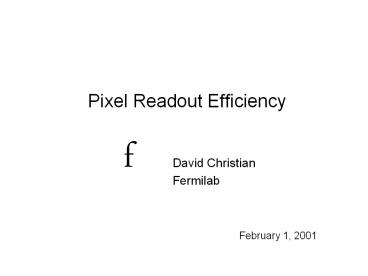Pixel%20Readout%20Efficiency - PowerPoint PPT Presentation
Title:
Pixel%20Readout%20Efficiency
Description:
Pixel Readout Efficiency David Christian Fermilab Pixel sensor efficiency Most probable charge deposited 24000 e-. Landau distribution MIP always deposits greater ... – PowerPoint PPT presentation
Number of Views:73
Avg rating:3.0/5.0
Title: Pixel%20Readout%20Efficiency
1
Pixel Readout Efficiency
- David Christian
- Fermilab
2
Pixel sensor efficiency
- Most probable charge deposited ? 24000 e-.
- Landau distribution ? MIP always deposits greater
than 14000 e-. - Sharing reduces the charge input to an individual
electronics pixel, but with a discriminator
threshold of 2000 e-, the detection efficiency is
gt99.9. - The fact that pixels provide space points are
100 efficient allows BTeV to use very simple
fast tracking algorithms is the key to the
success of the experiment.
3
Measured Landau Distribution (p-stop sensor)
Small Amount of Charge loss At corners Should not
be Present in Final sensors.
4
Readout Efficiency Simulation Methodology
- Generate pixel hits using BTeV Geant
- Minimum bias at 1E32, 2E32, 4E32, 6E32
- (Ave. of 1,2,4,6 interactions per crossing
- includes 1/500 B events w 2x normal
- track multiplicity 2E32 is nominal rate)
- Translate file of pixel hits (given for one
central plane) to list of hit pixels - x,y,dx/dz, dy/dz, ( pixels hit) ?
- list of (row,col,adc)
- Use Verilog to simulate FPIX2 core (periphery
assumed not to lose any data)
5
Step 1 BTeV Geant
- Well tested simulation Monte Carlo.
- Used (for proposal) to simulate detector response
to a variety of B decays of interest will be
maintained for use throughout the life of the
BTeV experiment. - Includes a pretty good guess of all material in
the active area. - Charged particles are propagated through magnetic
field allowed to scatter, interact, radiate
photons in material. - Neutrals propagated allowed to scatter,
interact, and (photons) pair produce ee-. - Simulation includes d-rays with energy gt 1 MeV
6
Step 2 Generate list of hit pixels
- FORTRAN program allows one to select an arbitrary
chip position with respect to the beam hole. - Uses track slope in x y to figure out which
pixels are traversed (includes sharing across
columns as well as across rows). - Adds a small dx dy to account for charge
diffusion. - Calculates ADC using track length in cell (simply
proportional to length no Landau).
7
Step 3 Verilog Simulation
- Very simple model of sensor/FPIX front end
- Two parameters are set depending on (input) 5-bit
pulse ht - Discriminator timewalk (with respect to BCO)
- Analog memory (time that no 2nd hit is allowed)
- Complete and accurate model of digital aspects of
FPIX core. - Models 160 rows x 18 columns
- Max. readout clock frequency determined by
- Horizontal vertical token passing
- With 160 rows, vertical token limits clock to ?
30 ns - Almost all data loss occurs because EOC timestamp
registers fill up. Minor EOC logic error
identified.
8
Representative (preliminary)Verilog Results
interactions per crossing R/O Eff. with 30 ns clock R/O Eff. with 25 ns clock
1 99.8
2 99.7
4 99.1 99.3
6 96.4 98.2
9
Known deficiencies
- Geant ignores d-rays below 1 MeV
- (can be added in step 2).
- Geant include no accelerator backgrounds, such
as tracks from beam-gas interactions or muons
from scraping on magnets, etc. - FORTRAN program (step 2) doesnt include magnetic
field effect (increases sharing across columns in
non-bend view by 12.5 changes sharing along
rows in the other view). - FORTRAN program doesnt yet include d-rays.
- Procedure underestimates multiplicity slightly
- (15-50)?
10
Trigger sensitivity to pixel inefficiency
Trigger loses efficiency quickly as pixel
efficiency degrades
Inner chip Efficiency Efficiency of Balance Trigger Efficiency for Bs ? DsK
100 100 74
99.5 99.5 72
99 99.5 71
97.5 99 99.5 68
Almost a 10 loss
11
What efficiency is achievable?
- Sources of loss
- Missing bump bonds
- Hot pixels
- Data loss in FPIX2
- Missing bumps
- Experience so far ? 0.1 is achievable
- (although most of the sensors we have tested so
far have regions containing no bumps amounting to
gtgt 0.1) - Hot pixels
- Very little experience (limited statistics)
- (1-2)/1300 in each FPIX1 sensor pixels
connected to two electronics pixels (1-2)/700
? 0.3 - Conclusion Missing bumps Hot pixels ? 0.5
12
Readout efficiency requirement (proposed)
Luminosity Inner chip efficiency Efficiency of balance Trigger Efficiency for Bs ? DsK
Nominal (2 x 1032) gt99.5 gt99.9 71
2 x Nominal (4 x 1032) gt99 gt99.8 70
3 x Nominal (6 x 1032) gt98 gt99.5 68































